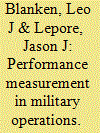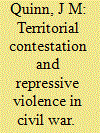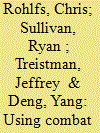| Srl | Item |
| 1 |
ID:
140260


|
|
|
|
|
| Summary/Abstract |
We explore the impact of strategic assessment efforts on military organizations at war. To do so, we construct a model to explore the impact of a principal’s choice among imperfect performance metrics for a military operation. In doing so, the principal must consider both the incentivizing and informational properties of the metric. We show the conditions under which uncertainty regarding the nature of the agent, as well as uncertainty regarding the operational environment, drives a metric choice that induces pathological behavior from the agent. More specifically, a poor metric choice can create an overly optimistic assessment and end up prolonging the conflict. We illustrate the model’s insights in the cases of World War II and the Vietnam War.
|
|
|
|
|
|
|
|
|
|
|
|
|
|
|
|
| 2 |
ID:
140261


|
|
|
|
|
| Summary/Abstract |
This study models the structural sources of variation in the use of selective (discriminate) repression within 89 civil wars fought between 1981 and 2005. The severity of repressive violence is modeled as a function of the amount of territory being contested by the insurgents. This idea is operationalized using measures of the location, size, and density of insurgency violence. The analysis finds evidence that the repressive behavior of both governments and rebel groups is linked to conflict geography. Governments violate physical integrity rights more frequently and kill more civilians the greater the overall amount of territory under contestation. Rebels kill more civilians in highly dispersed insurgencies that lack a clear epicenter.
|
|
|
|
|
|
|
|
|
|
|
|
|
|
|
|
| 3 |
ID:
140258


|
|
|
|
|
| Summary/Abstract |
This study investigates the effect that US medical personnel deaths in combat have on other unit deaths and ‘military success,’ which we measure using commendation medals as a proxy. We use a difference-in-differences identification strategy, measuring the changes over time in these outcomes following the combat loss of a medic or doctor and comparing it to the changes following the combat loss of a soldier who is not a medic or doctor. We find that overall unit deaths decrease in the five or ten days following the deaths of medical personnel in Vietnam, Korea, and the Pacific theater in World War II (WWII). In contrast, the WWII European and North African results indicate that overall unit deaths rise following medical personnel deaths. We find no relationship between medical personnel deaths and other unit deaths in Iraq and Afghanistan. For Korea and the Pacific theater of WWII, our estimates suggest unit commendation medals decrease following the deaths of medical personnel. This pattern of evidence is consistent with a model in which units often halted aggressive tactical maneuvers and reduced pursuit of their military objectives until deceased medical personnel were replaced. The results for the other conflicts are mixed and show little connection between medical personnel deaths and commendation medals.
|
|
|
|
|
|
|
|
|
|
|
|
|
|
|
|
| 4 |
ID:
140262


|
|
|
|
|
| Summary/Abstract |
This paper introduces a cost–benefit analysis for future nuclear weapon possession using natural numbers in a simple discrete time model. In essence, I focus on the expected values (probability multiplied by magnitude of detonations) of deliberate and accidental nuclear wars among unitary states. I take the United Kingdom’s current Trident renewal program as my case study. I seek to establish the expected value of a nuclear attack on the UK in the absence of nuclear weapons necessary to make the possession of nuclear weapons worthwhile. I find the net-value of nuclear weapons to be negative even under generous parametric values in their favor. I also discuss how our cognitive biases may affect the interpretation of the results. The analysis and discussion are limited to the UK, but the implications are likely to apply to other small nuclear weapon states, as well.
|
|
|
|
|
|
|
|
|
|
|
|
|
|
|
|
| 5 |
ID:
140259


|
|
|
|
|
| Summary/Abstract |
This paper examines how workplace goals affect the quality of worker output, using data from the recruiting command of the US Navy. Recruiting stations and recruiters are assigned monthly goals for the quantity of new recruits that may create an unintended incentive to sacrifice quality, especially towards the end of the month. Using data on the universe of Navy recruits from FY1998 to 2010, we find significant reductions in the quality of recruits towards the end of the contracting month, both in terms of pre-existing quality of recruits and in medium-term outcomes that reflect the quality of the job match.
|
|
|
|
|
|
|
|
|
|
|
|
|
|
|
|